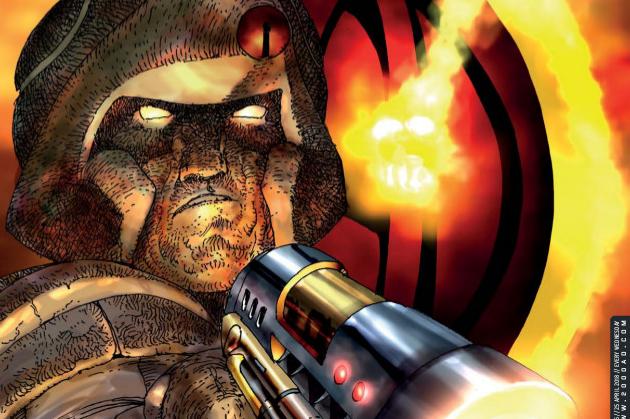2000AD, PROG 2078 REVIEW
Writers: TC Eglington; Gordon Rennie; Dan Abnett; Emma Beeby; John Wagner
Artists: Staz Johnson; Simon Coleby; Steve Yeowell; Mike Collins; Cliff Robinson; Carlos Ezquerra
Colourists: Abigail Bulmer; Len O'Grady; John Charles; Jose Villarrubia
Letterers: Annie Parkhouse; Ellie De Ville; Simon Bowland
Publisher: Rebellion
The game of distraction played by the far-right is examined further in Judge Dredd: Flaws. The Sons of Booth, supporters of the long-removed populist President “Bad” Bob Booth, have engineered a riot between pro- and anti-Judge factions, as a cover for a prison break. Flaws wonderfully demonstrates the popular tactic of stirring up tribal warfare whilst the real game is being played elsewhere, as well as the parasitic relationship that populist groups have with a media desperate for shocking content. As the people squabble over statues, a daring prison break is underway in a well put together action scene. This Dredd story hits all the (alt-)right notes, slowly building the Sons of Booth arc whilst being packed with satirical action.
The gritty, grubby warfare continues in Jaegir: In The Realm Of Pyrrhus. Whilst Atalia escapes with a high ranking Souther prisoner, further flashbacks dig deeper into the political machinations behind the war. Not only has Jaegir forced me to learn how to spell “Pyrrhus”, it builds upon the classic Rogue Trooper set up in a really interesting way. Nothing new or revolutionary is added that might cause us to question forty years of backstory, but rather more detail is slowly added to a familiar tale of treason and revenge. With a group of identically dressed characters travelling through a scorched landscape, the shadowy art of Jaegir could become confusing but an excellenct script keeps things moving along, whilst some gloriously simplistic colouring builds a shifting toxic landscape.
A shoot out with the Devil continues in Sinister Dexter: The Devil Don’t Care. A series of unfortunate events has forced Finnigan and Ramone to Billi Octavio from the magic infused hitman known only as The Devil. In less capable hands the puns and wordplay could become tired, but Sinister Dexter is a careful balance of action and humour. Look out for the minor details in Steve Yeowell’s art where the action heats up and characters leave the confines of their panels.
Things get even more confusing in Anderson PSI Division: Undertow. Anderson has been led to the Undercity, the ruins of old New York that lay beneath the streets of Mega City One. Accompanying her is Judge Karyn, whose backstory as a host to a vampire spirit builds upon a decade old story that hasn’t been explained to newer readers. Meanwhile, Judge Flowers converses with a mystery Japanese agent, and some sort of unexplained event involving psychics plays out across the city. Confusion reigns - which can be a great tool in storytelling. Slowly revealing details can draw the reader in, encouraging them to keep turning the page. Undertow, however, feels like confusion for its own sake. It’s filled with bizarre images, such as Anderson climbing up the side of a destroyed skyscraper, which seem completely incongruous (aren’t there stairs inside?). Characters and events are piled upon each other, introduced and then doing very little. Stripped back to its basics and shed of a few characters, this would be a really interesting story, but the style makes it extremely difficult to follow.
Kenton Sternhammer is on the hunt for the dangerous Glazers gang, whilst Johnny Alpha follows behind, trying to keep the inexperienced Kenton out of trouble. In terms of plot, this episode of Strontium Dog: The Son more important than thrilling. It’s a necessary stage between action scenes. But writer John Wagner keeps the pace up by throwing in a nicely concise shoot out, and a callback to the good old days by arming Kenton with his late father’s weapon of choice.





